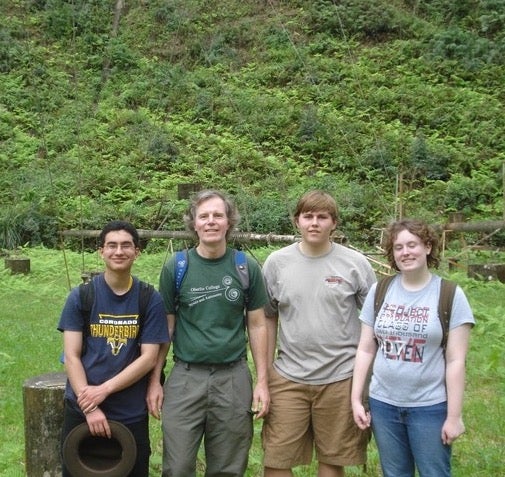Oberlin Researchers Part of Breakthrough Study on Gravitational Waves
Fifteen-year NSF-funded project involves dozens of students past and present, provides evidence of Einstein’s theory of relativity.
June 29, 2023
Communications Staff

NANOGrav's pulsar timing array, made up of 68 pulsars, detects gravitational waves believed to be caused by the movement of supermassive black holes.
Photo credit: courtesy of NANOGrav
Oberlin physics and astronomy students over the past 15 years—a roster of nearly 50 undergraduate researchers and their faculty mentors—played roles in a study on gravitational waves that has resulted in the publishing of significant findings that offer galaxy-sized evidence of Albert Einstein’s theory of relativity in action.
The research, conducted by the North American Nanohertz Observatory for Gravitational Waves and supported by the National Science Foundation, focuses on the use of radio telescopes that effectively transform an array of exotic stars into a gravitational-wave detector that can be likened to the size of an entire galaxy. Scientists believe that the waves detected may be caused by the movement of massive black holes—bodies as large as the distance between the earth and sun.
The NANOGrav research team, whose membership includes some 190 scientists across the U.S. and Canada, published its findings this week in the Astrophysical Journal Letters. Dan Stinebring, an emeritus professor of physics at Oberlin and a founding member of NANOGrav, is a senior researcher on the team and continues to work with current Oberlin students, often in tandem with Associate Professor of Physics Robert Owen, who is an expert in gravitation and a member of the Simulating Extreme Spacetime collaboration.
Within hours of the June 28 release of NANOGRav’s findings, reports of the research were published in the New York Times, the Washington Post, the Guardian, NPR, and Science, among other outlets.
The team’s research offers the first evidence of gravitational waves at very low frequencies. The newly detected waves, unlike high-frequency waves that have been observed by ground-based instruments, stand out because they can be perceived only by a detector that is much larger than Earth. NANOGrav’s detector, referred to as a “pulsar timing array”—literally a set of 68 pulsars, or remnants of previously massive stars—effectively functions as a galaxy-scale gravitational wave antenna. Pulsars are deemed a reliable tool for such study because they emit radio beams that are seen as highly regular pulses, rivaling in their timing stability the best collections of human-made atomic clocks.
As Einstein theorized, gravitational waves expand and contract space and time in a predictable pattern, causing changes in the intervals between pulses that can be detected across all 68 pulsars in the array. The gravitational waves observed in NANOGrav’s research are believed to result from orbiting pairs of supermassive black holes—each of them likely billions of times more massive than the Sun.

The array’s immense size has afforded researchers what is believed to be the first real-life glimpse of Einstein’s predicted correlation pattern between gravitational waves and the timing of pulses.
Within hours of the release of NANOGRav’s findings, reports of the research were published in the New York Times, the Washington Post, the Guardian, NPR, and Science, among other outlets.
“For the first time, we will be able to see evidence of the formation process of galaxies at a great distance,” says Stinebring, who notes that previous explorations of the universe have been made possible primarily through use of electromagnetic radiation. “That’s one channel,” he says. “But gravitational waves are a completely new channel. By using gravitational waves, we’re able to answer some questions we weren’t able to answer before.
“Based on what we know about each pulsar, we are able to predict far into the future when a particular pulse will arrive at our radio telescope,” says Stinebring, who retired from Oberlin in 2019 but remains active with the study and Oberlin’s student researchers. “Unbelievable as it sounds, we’re typically able to predict 10 years into the future to within a few millionths of a second. Then we actually measure the pulse arrival at that appointed time. The difference between when the pulse does arrive and when we predict it will arrive is called the residual. This is our main measurement.” These measurements are recorded every two weeks for each of the 68 pulsars that make up the array.

Oberlin is one of 66 U.S.-based member institutions in NANOGrav and one of only two Ohio colleges. Among most colleges and universities, Stinebring notes, student participation is limited to graduate- and postgraduate-level researchers.
Stinebring and his undergraduate researchers focus their efforts on “detector characterization,” which he likens to the work of a precision watchmaker, who would examine potential factors—such as temperature, humidity, or altitude—that could affect a watch’s accuracy over time.
“We need to do the same thing with every pulsar in our array,” he says.
With unsurprising precision, Stinebring readily produces a list of the Oberlin students, past and present, who have collaborated on the NANOGrav project. It numbers some 48 researchers, ranging from 2007 graduates to rising second-year student Lucilla Rubio Fernandez.
“I am very happy to look over that group of Oberlin students and see a wide range of abilities, backgrounds, and aspirations represented,” Stinebring says. “Many, of course, have gone on to further work in the physical sciences, an Oberlin tradition that I am proud to have contributed to.”
Learn more about the research and the implications of the team’s findings at the NANOGrav website.
You may also like…
Josh Nolan Named Vice President, General Counsel, and Secretary at Oberlin
Distinguished attorney brings extensive experience in higher education law.
Learning by Teaching: Oberlin Students Share Global Music with Young Learners
College and Conservatory students in PACE 103 prepare local children for an immersive community concert at Oberlin.
Nuiko Wadden ’02 Joins Oberlin Conservatory Faculty as Assistant Professor of Harp
The versatile musician brings extensive opera, orchestral, and contemporary music experience to her role


